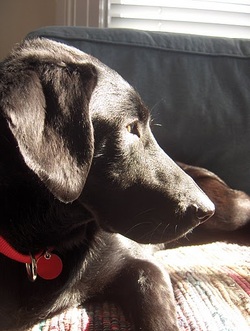
Whether this is your first family dog or one of many, there are a few things you can do to make this big transition easier for you and your pet.
Patience is the first step in the transition
It takes time to develop the close bonds we feel with our animals and it is common to have a “what have I done?” moment or two. Many of us underestimate how much time it takes for a new dog to understand the household rules and we forget that even our best-behaved pups didn’t start off as perfect angels.
Shelter life to new life
Just as you will need time to adjust, your dog will too. Shelter life is very different than living in a home, and many dogs find it exhausting. Do not be surprised if your new dog sleeps a lot, or is not very interested in food. Other dogs have difficulty relaxing and may be velcroed to your leg at first. Expect that your dog will need time to decompress, just like a kid returning from a summer at sleepover camp. The first weeks are the perfect time to agree on the house rules and establish a daily routine. Map out a schedule including meal times, potty breaks, exercise walks, play times, quiet time and training times. Not only will the consistency help your dog feel at home, it is the fastest way to house train a new dog.
Housetraining
A few lucky owners will find their newly adopted dog is already house trained. More often however, adopted dogs were not fully house trained in a previous home or have forgotten due to shelter living. It is best to expect that your new adult dog will need a refresher course. To do this, you will need to provide a safe and comfortable confinement space for your dog. Think of the confinement space like your dog’s bedroom, it is where she can safely and comfortably hang out when unsupervised or when the world gets to be too much. A family room, a kitchen blocked off with a baby gate, a bathroom or a crate are good options. The best confinement spaces are close to where your family spends a lot of time, but not somewhere your dog can get into mischief when you are not around. Choose a space with tile or linoleum floors. Puppy-proof the room by installing child-proof locks on cabinets that contain medications or cleaning products. Survey the room from a dog’s perspective and remove anything that might be seen as a game or food including: toilet paper rolls, waste paper baskets, food on the counter and hanging hand towels.
The necessities
Provide your dog with a soft bed, a bowl of water and a few durable chew toys. A rubber Kong toy stuffed with tasty treats makes a wonderful distraction and will help your dog learn to love her new bedroom. At some point all dogs will need to be left home alone and this can be a challenge for a newly adopted dog. Many of us are so excited with our new pet that we spend Saturday and Sunday by their side and then leave them for hours at a time on Monday morning. Start on day one to teach your dog that her bedroom is a safe and special place to be. Stuff a Kong toy with something delicious and give it to your dog in her confinement area. When she is busy chewing, nonchalantly head to another room without saying anything to your dog. As long as your dog is quiet, return a few minutes later and ignore her as if you’ve never left. If you do this a few times a day, your dog will learn that this is her safe zone and that people come back soon.
Confinement and routine
A confinement space and establishing a regular routine will help prevent the mistakes that newly adopted dogs regularly make when entering new homes. Once you know your dog will not pee on carpets or chew furniture, you can leave him in a larger space in the house or with doggie door access to outside. Starting off small is also the key to introducing him to his extended network of friends and family. Instead of the dog park, meet up with a doggie friend for a neighborhood walk and save the huge “welcome home” bash for a one year adoption anniversary party. Once you get to know your dog and what he loves, you can tailor his social life to match his personality.
Basic manners
The first few weeks are also the time to get started on basic manners training. Some adult rescue dogs know a few commands while others are a clean slate and ready to learn. Teaching your dog to look at you when you say his name is always a good first step. Grab a handful of your dog’s dinner and move all around the house and yard saying his name and tossing him a treat. You may want to consider attending a family-friendly reward based training class. Even if you’ve done training before, it is a fun way to bond with your dog and stay current with modern training techniques. Remember to take pictures to share with your dog’s friends at the rescue. Everyone loves to celebrate a happy ending!
Lisa Perreault is a Certified Pet Dog Trainer. She teaches classes and offers private behavior consultations through her company My Well Mannered Mutt. Lisa lives in Mountain View with her husband and two mutts.

 RSS Feed
RSS Feed